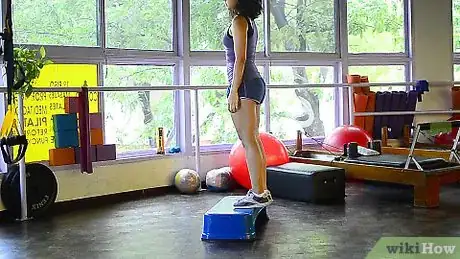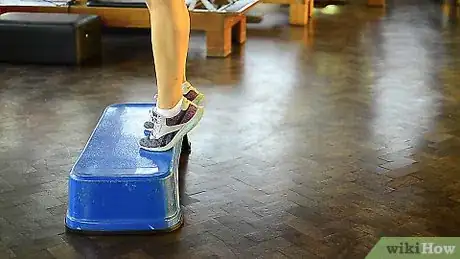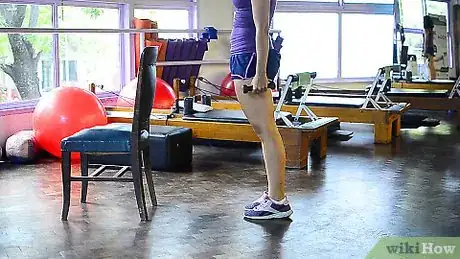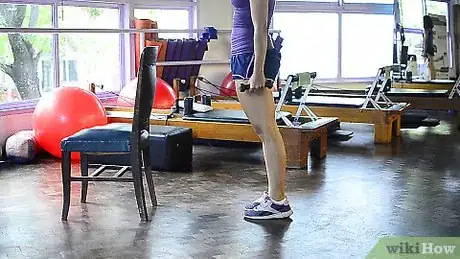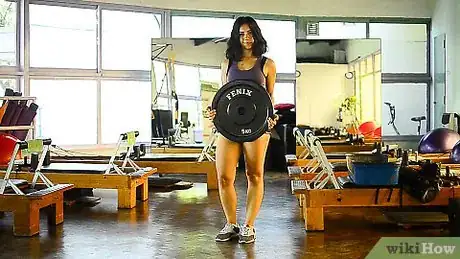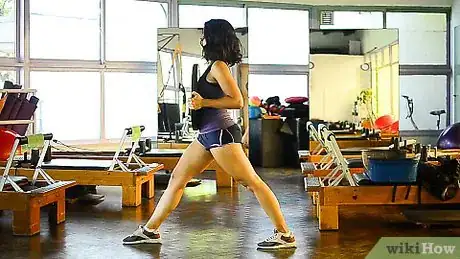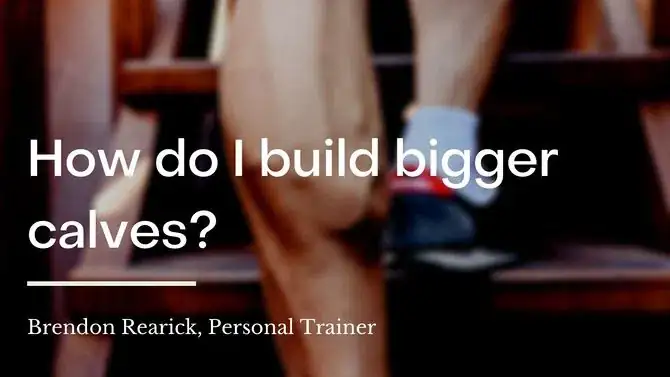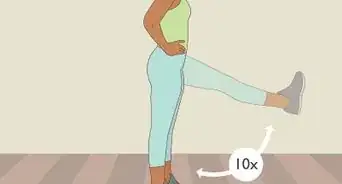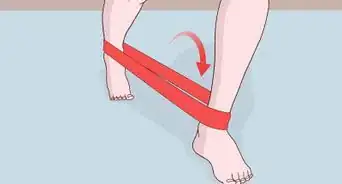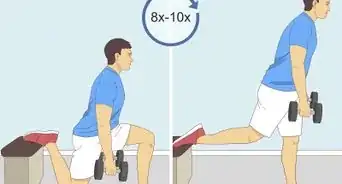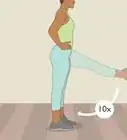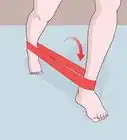This article was co-authored by Michele Dolan. Michele Dolan is a BCRPA certified Personal Trainer in British Columbia. She has been a personal trainer and fitness instructor since 2002.
wikiHow marks an article as reader-approved once it receives enough positive feedback. In this case, 88% of readers who voted found the article helpful, earning it our reader-approved status.
This article has been viewed 853,953 times.
While well-shaped and toned calf muscles can make a pretty impression while playing baseball or wearing a nice pair of heels, there's much more to them: they perform the crucial function of maintaining the skeleton's proper alignment. Feel like getting your calves in shape? There are quite a few exercises that you can do in the comfort of your home. Read on to find out how to properly perform calf raises.
Steps
Practicing Standing Calf Raises
-
1Stand on the edge of a stair step, or a step of any kind (as long as it's in a safe environment). Make sure the step is not very far up and close to the ground. You don't want to fall too far should you lose your balance[1] .
If you're using a step-aerobics platform, you might want to slide two risers beneath the step.
-
2Stand straight, with your tailbone tucked in. Engage your core by pulling in your upper ribs and belly. Make sure that the balls of your feet are solidly planted on the edge of the step. Your heels should be over the edge.
- If you feel unstable, or like you're losing your balance, practice this method with a wall or railing near by.
- Place your hands on the wall or the railing.
Advertisement -
3Lift your heels until you're standing on your tippy toes. Distribute most of your weight onto the balls of your feet, and keep your legs straight.
-
4Stay on your tippy toes for two seconds. Then, begin to lower your heels, and move your weight away from the balls of your feet. Lower your heels until they're below the step, or platform[2] .
- You should be feeling your calf muscles stretch on the downward movement.
- Repeat this sequence until you feel tired.
Practicing Dumbbell Calf Raises
-
1Hold a dumbbell in each hand. It's always a good rule of thumb to start with lighter weights, and work your way up to heavier ones. Get two dumbbells of the same weight, and stand with your feet about shoulder width apart[3] .
-
2Keep a chair at arms' length in front of you. If you have trouble with your balance, it's a good idea to have a chair nearby with the back facing you. You can also perform this exercise while facing a wall.
-
3Let your arms hang along the sides of your body. Make sure that your arms are below your shoulders, and keep a firm grip on the dumbbells.
-
4Lift your heels up. Shift your weight onto the balls of your feet while keeping your legs straight. Continue to keep your arms alongside your body[4] .
- There is no arm movement involved, as the weights are meant to train your calf muscles.
- While your legs should be straight, it's a good idea to keep a micro bend in your knees to avoid locking them up.
-
5Slowly lower your heels back to the floor. Do this movement with as much control as possible[5] .
You should feel a nice stretch and little tension in your lower legs, particularly your calves.
-
6Practice this exercise sequence twelve to fifteen times in a row. That's an adequate number of repetitions for most people, and should gradually strengthen your calf muscles.
Practicing The Split Stance Overhead Calf Raise
-
1Start with a lighter weight. For best results in this method, you'll need a plate weight, like you would find at the gym. Resist the urge to start with the heaviest weight you can manage. It's better to start with a lighter weight and work your way up.
-
2Stand with your legs one in front of the other. In other words, your legs should be scissoring out, resulting in about a foot distance between both feet.
-
3Hold the plate weight to your chest with both hands. This is the time to decide if the weight is too little or too much. Err on the side of caution, and go with a slightly lower weight than you might be able to hold.
-
4Bend the front knee, with the knee over your ankle. Take a step back with your back knee so that the back leg is almost straight. Then, lift your back heel so that you're on the tippy toes of your back foot.
-
5Raise your front heel. Both feet should now be on their tippy toes. Lower the heel of your front foot slowly until it's back on the floor. Keep the back heel lifted the entire time. Lift the front heel, hold it for a moment, then lower it back to the ground.
-
6Repeat this exercise. Ideally, you should strive to practice this method of the calf raise a few times per week.
Expert Q&A
-
QuestionHow do I build bigger calves?
 Brendon RearickBrendon Rearick is a Personal Trainer, Strength Coach, Fitness Program Director, and co-founder of Certified Functional Strength Coach (CSFC), a fitness education company in the San Francisco Bay Area. With 17 years of experience in the fitness industry, Brendon specializes in strength and conditioning, and his company CSFC has certified over 3,000 trainers in over 20 countries. Brendon has worked as a Program Director for Mike Boyle Strength and Conditioning (MBSC) and earned his massage therapy license from the Cortiva Institute-Boston. Brendon holds a BS in Kinesiology from the University of Massachusetts Amherst.
Brendon RearickBrendon Rearick is a Personal Trainer, Strength Coach, Fitness Program Director, and co-founder of Certified Functional Strength Coach (CSFC), a fitness education company in the San Francisco Bay Area. With 17 years of experience in the fitness industry, Brendon specializes in strength and conditioning, and his company CSFC has certified over 3,000 trainers in over 20 countries. Brendon has worked as a Program Director for Mike Boyle Strength and Conditioning (MBSC) and earned his massage therapy license from the Cortiva Institute-Boston. Brendon holds a BS in Kinesiology from the University of Massachusetts Amherst.
Personal Trainer & Strength Coach
-
QuestionHow many reps of calf raises should I do?
 Michele DolanMichele Dolan is a BCRPA certified Personal Trainer in British Columbia. She has been a personal trainer and fitness instructor since 2002.
Michele DolanMichele Dolan is a BCRPA certified Personal Trainer in British Columbia. She has been a personal trainer and fitness instructor since 2002.
Certified Fitness Trainer Three sets of 10-15 calf raises is a great start. Try single leg calf raises once that becomes easy.
Three sets of 10-15 calf raises is a great start. Try single leg calf raises once that becomes easy. -
QuestionWhat do calf raises work out?
 Michele DolanMichele Dolan is a BCRPA certified Personal Trainer in British Columbia. She has been a personal trainer and fitness instructor since 2002.
Michele DolanMichele Dolan is a BCRPA certified Personal Trainer in British Columbia. She has been a personal trainer and fitness instructor since 2002.
Certified Fitness Trainer Calf raises work out the muscles in the back of the lower leg, which is known as the "calf."
Calf raises work out the muscles in the back of the lower leg, which is known as the "calf."
Warnings
- Potential injuries to your Achilles Tendon may be incurred if this exercise is performed incorrectly. Be particularly careful—injuring this tendon may cause you lifelong problems.⧼thumbs_response⧽
- Those with poor balance should be careful when performing these exercises.⧼thumbs_response⧽
Things You Need
- Dumbbells (optional)
- Towel (optional)
- Plate Weight (optional)
References
- ↑ http://www.dummies.com/how-to/content/how-to-do-the-standing-calf-raise.html
- ↑ http://www.bodybuilding.com/exercises/detail/view/name/standing-calf-raises
- ↑ http://www.mayoclinic.org/healthy-living/fitness/multimedia/calf-raise/vid-20084681
- ↑ http://www.mayoclinic.org/healthy-living/fitness/multimedia/calf-raise/vid-20084681
- ↑ http://www.mayoclinic.org/healthy-living/fitness/multimedia/calf-raise/vid-20084681
- Videos provided by Insane Home Fat Loss
About This Article
To exercise and tone your muscles with calf raises, stand up straight on the edge of a stair step, with a wall or railing nearby to help you balance. Then, lift your heels so that you’re on your tip toes and hold the position. After 2 seconds, lower your heels so that they’re below the level of the step and you can feel the stretch in your calf muscles. Repeat this up-and-down motion until you get tired. For a more intense workout, you can hold a dumbbell in each hand with your arms at your sides while doing calf raises. To learn more from our Personal Trainer co-author, like how to do split stance calf raises, keep reading!
